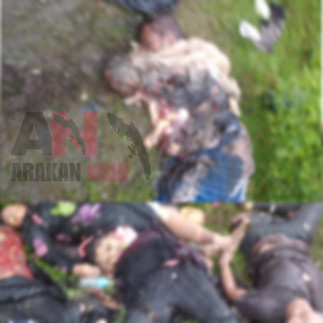
Eyewitness Account: What Survivors Say About the Naf River Massacre on 5 August 2024
- Arakan Now

- Aug 6
- 3 min read
Arakan Now | 6 August 2025
Arakan Now interviewed an eyewitness, Shokot Noor (18), from Myoma Kya Yin Tan, Maungdaw township, about 5 August 2024 Naf River Massacre.
Warning: This post contains graphic content, including images of dead children, elderly people, and injured civilians. Viewer discretion is advised.
Shokot Noor shared his full story, recalling what he experienced during the 5 August 2024 Naf River massacre. His words tell of a long journey of fear, displacement, loss, and survival.
“The conflict began in Maungdaw township in early 2024. Roads were blocked, and all the bridges were destroyed. People could not move to safer places. Prices of goods went up, and we could not live a normal life.”
“Drones attacked our village again and again. Many people were injured or killed. I saw it with my own eyes. We could not leave our homes because the drones were flying above us.”
“For around one and a half months, we hid inside strong concrete buildings to protect ourselves. These drones were sent by the Arakan Army (AA), and life was very unstable.”
“After many drone attacks, we had no choice but to flee. We went to my sister’s house in Maungdaw Ward-2 (Haare Fara). We stayed there for about one month.”
“But even in Ward-2, the situation got worse. AA and the military kept fighting. The AA had set up a post in our village, so they kept launching drones and artillery attacks. Many people from our village also ran to Ward-2 to save their lives.”
“Then the AA started launching artillery into Ward-2 too. People were dying every day. It was no longer safe to stay there either.”
“We heard that the AA had arrived in Maung Ni village tract. They killed and abducted civilians. People from there began running toward the downtown area, trying to cross into Bangladesh.”
“We also went to the riverbank at locally called Fawzi Fara, near Pyin Taw Pin village tract, to try to cross the river. We were 14 family members waiting for a boat.”
“Then drones came. At around 6 PM on 5 August 2024, the drone attack hit us directly while we waited for the boat. Nine of my family members died in front of me: my father, mother, three sisters, my big brother’s child, my sister’s mother-in-law, and my brother-in-law.”
“Five of us were injured. My elder brother Anis lost his leg. My big brother, his wife, and I were all wounded. My nephew was also injured in the leg and stomach.”
“We were all separated and couldn’t help each other because of our injuries. My brother Anis was bleeding a lot. My big brother carried him toward Bangladesh, but they were stopped and taken by an armed group.”
“Anis died because they delayed his medical care. After that, my big brother Amin was released and reached Bangladesh for treatment.”
“I was left at the riverbank, unable to move. I saw more than 100 dead bodies around me, including my own family.”
“I also saw armed men take money and gold from the bags of the dead, including our own bags. I begged them to help me, but they did not care.”
“Later, a friend from my village found me and helped me. I asked him to take me to Bangladesh. He agreed, but the boatman refused to carry me because my condition was serious.”
“Still, my friend managed to carry me to Bangladesh. A relative found me and took me to the MSF Hospital in Kutupalong, Cox’s Bazar.”
“I stayed there for six days, but I wasn’t getting better because there were bomb fragments left inside my stomach. They sent me to another hospital in Cox’s Bazar, but they could not treat me properly due to lack of tools.”
“Then, my relatives took me to another hospital in Chokoria. I stayed there for about three months.”
“I finally recovered, could stand up, and walk again. But we never had the chance to bury my family members.”



















